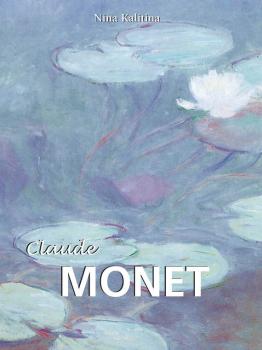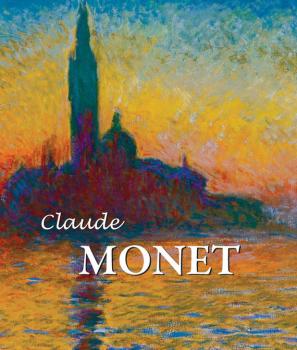Nina Kalitina
Список книг автора Nina KalitinaClaude Monet
Para Claude Monet, el que se le considerara “impresionista” fue siempre un motivo de orgullo. A pesar de todas las críticas que se han hecho a su trabajo, siguió siendo un verdadero impresionista hasta el final de su muy larga vida. Lo era por convicción profunda y, por el impresionismo, pudo haber sacrificado muchas otras oportunidades que su inmenso talento le ofrecía. Monet no pintaba composiciones clásicas con figuras y nunca fue retratista, aunque su entrenamiento profesional incluía estas habilidades. Eligió un solo género y lo hizo suyo: el paisajismo, y en él logró un grado de perfección que ninguno de sus contemporáneos pudo conseguir. Sin embargo, cuando era niño, comenzó por dibujar caricaturas. Boudin aconsejó a Monet que dejara de hacer caricaturas y se dedicara a los paisajes. El mar, el cielo, los animales, las personas y los árboles son hermosos en el estado en que la naturaleza los creó, rodeados de aire y luz. De hecho, fue Boudin quien trasmitió a Monet su convicción de la importancia de trabajar al aire libre, que a su vez, Monet transmitiría a sus amigos impresionistas. Monet no quiso asistir a la Escuela de Bellas Artes. Eligió estudiar en una escuela privada, L’Académie Suisse, fundada por un ex-modelo en Quai d’Orfèvres, cerca del puente Saint-Michel. Ahí era posible dibujar y pintar modelos vivos por una tarifa modesta. Ahí conoció también al futuro impresionista Camille Pissarro. Más tarde, en el estudio de Gleyre, Monet conoció a Auguste Renoir, Alfred Sisley y Frédéric Bazille. Monet consideraba muy importante presentar a Boudin a sus nuevos amigos. También le habló a sus amigos de otro pintor que había encontrado en Normandía. Se trataba del holandés Jongkind. Sus paisajes estaban saturados de color y su sinceridad, que en ocasiones rayaba en inocencia, combinaba la sutil observación de la naturaleza cambiante de la costa normanda. En aquella época, los paisajes de Monet aún no se caracterizaban por una gran riqueza de color. Más bien recordaban las tonalidades de pinturas de los artistas de la escuela de Barbizon y las marinas de Boudin. Compuso un rango de colores basados en amarillo a marrón o en azul a gris. En la tercera exhibición impresionista en 1877, Monet presentó una serie de pinturas por primera vez: siete vistas de la estación ferroviaria de Saint-Lazare. Las seleccionó entre doce que había pintado en la estación. Este motivo en el trabajo de Monet es coherente no sólo con la obra Chemin de fer (El ferrocarril) de Manet y con sus propios paisajes en los que aparecían trenes y estaciones en Argenteuil, sino también con una tendencia que surgió tras la aparición de los primeros ferrocarriles. En 1883, Monet compró una casa en el poblado de Giverny, cerca del pequeño pueblo de Vernon. En Giverny, pintar series se convirtió en una de sus ocupaciones principales. Los prados se convirtieron en su lugar de trabajo permanente. Cuando un periodista que había llegado desde When Vétheuil a entrevistar a Monet le preguntó dónde estaba su estudio, el pintor le respondió: “¡Mi estudio! Nunca he tenido uno y no veo la razón por la que alguien quiera encerrarse en una habitación. Para dibujar, sí, pero para pintar, no”. Entonces hizo un gesto amplio para abarcar el Sena, las colinas y la silueta de un pequeño pueblo y declaró: “Este es mi verdadero estudio”. Monet empezó a ir a Londres en la última década del siglo XIX. Comenzó todas sus pinturas de Londres copiando directo de la naturaleza, pero completó muchas de ellas después, en Giverny. La serie formó un todo indivisible y el pintor tuvo que trabajar en cada uno de sus lienzos en algún momento. Un amigo de Monet, el escritor Octave Mirbeau, escribió que había logrado un milagro. Con aquellos colores logró recrear en el lienzo algo casi imposible de capturar: reprodujo la luz del sol, enriqueciéndola con un número infinito de reflejos. Como ningún otro de los impresionistas, Claude Monet adoptó una perspectiva casi científica de las posibilidades del color y la llevó hasta el límite; es poco probable que alguien más lograra llegar tan lejos como él en esa dirección.
Claude Monet
Als Impressionist zu gelten war für Monet eine Auszeichnung. Er war es aus tiefer Überzeugung und blieb es bis an das Ende seines langen Lebens. Er begnügte sich mit einem einzigen Genre, dem der Landschaftsmalerei. Hier aber brachte er es zu einer Vollkommenheit, an die keiner seiner Zeitgenossen heranreichte. Im Sommer jenes Jahres kam es zu gemeinsamen Malübungen mit Boudin (1824 bis 1898) am Meeresstrand. “Mit der Zeit gingen mir die Augen auf und ich begann, die Natur zu verstehen; zugleich lernte ich, sie zu lieben” – so erinnert sich Monet später an diese gemeinsamen Exerzitien. Er besucht nicht die Ecole des Beaux-Arts, sondern zieht die von Monsieur Suisse, einem ehemaligen Modell Davids, gegründete freie “Académie Suisse” vor. Hier war es möglich, für einen geringen Beitrag lebende Modelle zu malen und zu zeichnen. Die Farbskala der Bilder, die Monet 1871 und 1872 malte, ist nicht sehr breit; sie erinnert an die der Barbizon-Schule und an die Seestücke Boudins. Die Grundtöne sind braungelb und blaugrau. Im Jahr 1877 wurde die dritte Ausstellung der Impressionisten eröffnet, bei der Monet zum ersten Mal eine Bilderserie zeigte. Mit seinem Motiv, dem Bahnhof Saint-Lazare, setzte Monet nicht nur Manets Die Eisenbahn und seine eigenen Landschaftsbilder aus Argenteuil fort, er schloss sich darüber hinaus der bei den Künstlern wachsenden Tendenz an, sich von diesem Transportmittel faszinieren zu lassen. In seinem Wohnort Giverny wurden die Bilderserien Monets wichtigste Arbeitsmethode. In den 1890er Jahren entdeckte Monet London. Zwar begann er die Bilder allesamt in London, beendete viele von ihnen aber in Giverny. Für den Schriftsteller Octave Mirbeau (1848 bis 1917) war Monet ein Mensch, der Wunder vollbrachte: Mit Hilfe der Farben habe er auf der Leinwand das Sonnenlicht, etwas nahezu Unfassbares, nachgebildet und es um eine Unzahl prismatischer Facetten bereichert. Tatsächlich hat Monet das Potenzial der Farbe mit nahezu wissenschaftlicher Strenge bis zu seinen äußersten Konsequenzen getrieben; kein anderer Impressionist ist darin so weit gegangen wie er, und es ist wenig wahrscheinlich, dass man in dieser Richtung hätte noch weitergehen können.
Claude Monet
For Claude Monet the designation ‘impressionist’ always remained a source of pride. In spite of all the things critics have written about his work, Monet continued to be a true impressionist to the end of his very long life. He was so by deep conviction, and for his Impressionism he may have sacrificed many other opportunities that his enormous talent held out to him. Monet did not paint classical compositions with figures, and he did not become a portraitist, although his professional training included those skills. He chose a single genre for himself, landscape painting, and in that he achieved a degree of perfection none of his contemporaries managed to attain. Yet the little boy began by drawing caricatures. Boudin advised Monet to stop doing caricatures and to take up landscapes instead. The sea, the sky, animals, people, and trees are beautiful in the exact state in which nature created them – surrounded by air and light. Indeed, it was Boudin who passed on to Monet his conviction of the importance of working in the open air, which Monet would in turn transmit to his impressionist friends. Monet did not want to enrol at the Ecole des Beaux-Arts. He chose to attend a private school, L’Académie Suisse, established by an ex-model on the Quai d’Orfèvres near the Pont Saint-Michel. One could draw and paint from a live model there for a modest fee. This was where Monet met the future impressionist Camille Pissarro. Later in Gleyre’s studio, Monet met Auguste Renoir Alfred Sisley, and Frédéric Bazille. Monet considered it very important that Boudin be introduced to his new friends. He also told his friends of another painter he had found in Normandy. This was the remarkable Dutchman Jongkind. His landscapes were saturated with colour, and their sincerity, at times even their naïveté, was combined with subtle observation of the Normandy shore’s variable nature. At this time Monet’s landscapes were not yet characterized by great richness of colour. Rather, they recalled the tonalities of paintings by the Barbizon artists, and Boudin’s seascapes. He composed a range of colour based on yellow-brown or blue-grey. At the Third Impressionist Exhibition in 1877 Monet presented a series of paintings for the first time: seven views of the Saint-Lazare train station. He selected them from among twelve he had painted at the station. This motif in Monet’s work is in line not only with Manet’s Chemin de fer (The Railway) and with his own landscapes featuring trains and stations at Argenteuil, but also with a trend that surfaced after the railways first began to appear. In 1883, Monet had bought a house in the village of Giverny, near the little town of Vernon. At Giverny, series painting became one of his chief working procedures. Meadows became his permanent workplace. When a journalist, who had come from Vétheuil to interview Monet, asked him where his studio was, the painter answered, “My studio! I’ve never had a studio, and I can’t see why one would lock oneself up in a room. To draw, yes – to paint, no”. Then, broadly gesturing towards the Seine, the hills, and the silhouette of the little town, he declared, “There’s my real studio.”Monet began to go to London in the last decade of the nineteenth century. He began all his London paintings working directly from nature, but completed many of them afterwards, at Giverny. The series formed an indivisible whole, and the painter had to work on all his canvases at one time. A friend of Monet’s, the writer Octave Mirbeau, wrote that he had accomplished a miracle. With the help of colours he had succeeded in recreating on the canvas something almost impossible to capture: he was reproducing sunlight, enriching it with an infinite number of reflections. Alone among the impressionists, Claude Monet took an almost scientific study of the possibilities of colour to its limits; it is unlikely that one could have gone any further in that direction.


